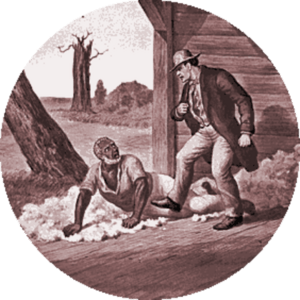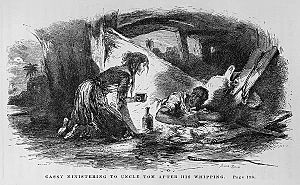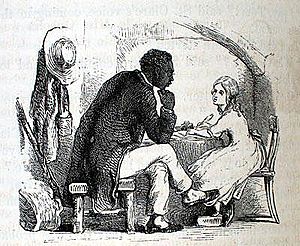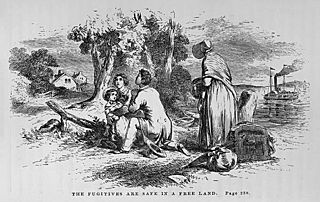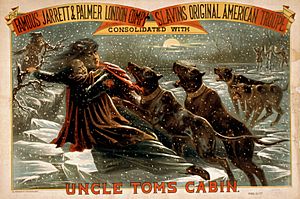Uncle Tom's Cabin facts for kids
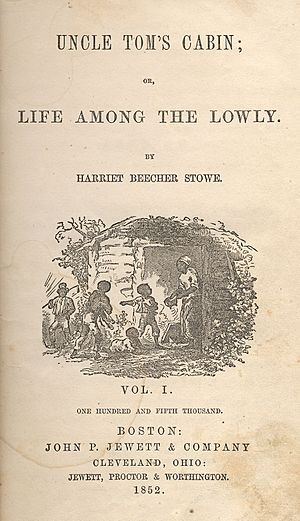 |
|
| Author | Harriet Beecher Stowe |
|---|---|
| Illustrator | Hammatt Billings (1st edition) |
| Country | United States |
| Language | English |
| Genre | Novel |
|
Publication date
|
March 20, 1852 |
| Media type | Print (Hardback and Paperback) |
| OCLC | 950905879 |
| Followed by | A Key to Uncle Tom's Cabin (1853) |
Uncle Tom's Cabin; or, Life Among the Lowly is a famous novel written by Harriet Beecher Stowe. It was published in 1852. This book was written to be against slavery. It greatly changed how many people in the United States thought about African Americans and slavery.
The book also made the differences between the North and South even stronger. This eventually led to the American Civil War. The book was so powerful that Abraham Lincoln might have said to Stowe, "So this is the little lady who made this big war."
The main character is Uncle Tom. He is a kind and patient man. The novel shows the terrible effects of slavery. It also teaches that Christian love is stronger than slavery.
Uncle Tom's Cabin was the most popular novel of the 1800s. It was the second best-selling book of that century, after the Bible. It helped the movement to end slavery, called abolitionism, grow in the 1850s.
Today, the book is praised for its important role in fighting slavery. However, some people also criticize it. They say it created stereotypes about black people.
Contents
How Uncle Tom's Cabin Was Published
Uncle Tom's Cabin first appeared as a series of stories. These stories were printed in The National Era, an anti-slavery newspaper. Harriet Beecher Stowe had written other works for this newspaper before.
People loved the story so much that a publisher named John P. Jewett from Boston asked Stowe to make it into a book. Stowe was not sure if people would buy it as a book. But she finally agreed.
John Jewett was sure the book would be popular. He asked Hammatt Billings to draw six pictures for the book. The finished book came out on March 20, 1852. By June, it was selling 10,000 copies every week. By October, 150,000 copies had been sold in America alone. In its first year, 300,000 copies were sold. It was also translated into many important languages.
Story Summary
Eliza Escapes and Tom Is Sold
A farmer in Kentucky named Arthur Shelby is worried. He might lose his farm because of debts. He and his wife, Emily Shelby, are usually kind to their slaves. But Mr. Shelby decides to sell two of them. One is Uncle Tom, a middle-aged man with a wife and children. The other is Harry, the son of his wife's maid, Eliza.
Emily Shelby is very upset. She had promised Eliza that she would never sell her son. Their son, George Shelby, is also sad. He looks up to Uncle Tom as a friend and a good Christian.
When Eliza hears about Mr. Shelby's plan, she decides to run away with Harry. She writes a letter to Mrs. Shelby saying she is sorry. Then, she runs away that night.
Meanwhile, Uncle Tom is sold. He is put on a boat that travels down the Mississippi River. On the boat, he meets a young girl named Evangeline, or "Eva." When Eva falls into the water, Tom saves her. Eva's father, Augustine St. Clare, then buys Tom. Eva and Tom become very good friends. They both have a deep love for Jesus.
Eliza's Family Is Hunted, Tom's Life with St. Clare
During Eliza's escape, she meets her husband, George Harris. He had run away earlier. They decide to try to reach Canada to be free. However, a slave hunter named Tom Loker hunts them.
Tom Loker finally traps Eliza and her family. George shoots Loker. Eliza worries that Loker might die and go to hell. So, she persuades her husband to take him to a Quaker town. There, Loker can get better. The kind Quakers greatly change Tom Loker.
In St. Clare's house, St. Clare often argues with his sister, Miss Ophelia. She believes slavery is wrong. But she has prejudice against black people. St. Clare buys a black child named Topsy. He challenges Miss Ophelia to educate her. Miss Ophelia tries, but she does not succeed at first.
After Tom has lived with St. Clare for about two years, Eva becomes very sick. Before she dies, she has a vision of heaven. Her death changes many people. Miss Ophelia loses her prejudice against black people. Topsy decides to become "good." St. Clare decides to free Tom.
Tom's Life with Simon Legree
St. Clare is hurt when he tries to stop a fight at a tavern. He dies from his injuries. Because of this, he cannot keep his promise to free Tom. His wife sells Tom to a plantation owner named Simon Legree.
Legree takes Tom to Louisiana. There, Tom meets other slaves, including Emmeline. Legree bought Emmeline at the same time as Tom. Legree begins to hate Tom when Tom refuses to whip other slaves. Legree beats him. He decides to try to destroy Tom's faith in God. However, Tom secretly keeps reading the Bible and helping other slaves.
At the plantation, Tom meets Cassy, another black slave. Her two children had been sold. She had killed her third child because she was afraid that child would also be sold.
Loker has changed because of the Quakers. George, Eliza, and Harry finally reach Canada and become free. Meanwhile, Uncle Tom feels so unhappy that he almost gives up. But he has two visions of Jesus and Eva. He decides to remain a Christian, even if it means dying.
Cassy and Emmeline run away with Tom’s encouragement. They cleverly use Legree’s superstitious fears to help them. When Tom does not tell Legree where they are, Legree orders his men to beat Tom to death. Tom forgives the two men who beat him as he dies. They feel sorry and become Christians.
George Shelby arrives just as Tom is dying to free him. He is very angry and sad. But Tom dies smilingly, saying, "Who,—who,—who shall separate us from the love of Christ?"
Important Characters
Uncle Tom: A Noble Hero
Uncle Tom is the main character. He is a patient, noble, and unselfish black slave. Harriet Beecher Stowe wanted him to be a "noble hero." In the book, he stands up for what he believes. Even his enemies admire him, even if they do not want to.
Today, his name "Uncle Tom" is sometimes used negatively. People might think of an old black man who tries to please his masters. They criticize his quiet acceptance of slavery. However, others argue this is not true. Uncle Tom is not old; he is only about fifty. Also, Tom is not happy with slavery. His acceptance comes from his religious faith, which tells him to love everyone.
Wherever Uncle Tom goes, he shares love, comfort, and kindness. He helps slaves escape, like Eliza, Emmeline, and Cassy. He also refuses to beat other slaves. Because of this, he is beaten himself. Stowe wanted Tom to be an example for all people, not just black people. She believed that if white people were loving and unselfish like Uncle Tom, slavery would be impossible.
Eliza Harris: A Brave Mother
Eliza Harris is Mrs. Shelby's favorite maid. She is George Harris's wife and Harry's mother. Eliza is a brave, intelligent, and very beautiful young slave. She loves her son, Harry, very much. Her love for him might have been even stronger because she had lost two other baby children.
Her motherly love is clear when she bravely escapes with her son. Perhaps the most famous part of Uncle Tom's Cabin is when Eliza escapes across the Ohio River with Harry.
This escape story was inspired by a real event. John Rankin told the story to Stowe's husband, Calvin. In 1838, a young slave woman escaped across the frozen Ohio River. She carried her child and stayed at Rankin's house before going further north.
Eva: A Christ-like Child
Eva "Evangeline" St. Clare is the angelic daughter of St. Clare and Marie. She enters the story when Tom saves her from drowning. Tom was on his way to be sold. Eva asks her father to buy Tom. She says, "I want to make him happy." Because of her, Tom becomes St. Clare's main coachman and Eva's special helper.
Eva is very beautiful. Her face is known for its strange and serious expression. This makes her different from other children. Everyone turns to look at her.
To Tom, she seems almost divine. When her golden head and blue eyes look at him, he almost believes he sees an angel from his New Testament. He says, "She's got the Lord's mark in her forehead." Eva is an almost perfect, Christ-like child. She is very sad about slavery. She does not see differences between black and white people. She talks a lot about love and forgiveness. Even Topsy is touched by her love. Eva becomes one of the most important people in Tom's life.
Ophelia St. Clare: Learning to Love
"The higher circle in the family...agreed that she was no lady...they were surprised that she should be any relation of the St. Clares...She sewed and stitched away, from daylight till dark, with the energy of one who is pressed on by some immediate urgency; and then, when the light faded (went away)...out came the ever-ready knitting-work, and there she was again, going on as briskly (busily) as ever. It really was a labor to see her."
Ophelia St. Clare is one of the most complicated female characters in the novel. St. Clare calls her "desperately good." She does not like slavery. However, she does not like to be touched by or close to any black person as a human being. When she first saw Eva shaking hands and kissing black people, she said it "made her feel sick." She added, "I want to be kind to everybody...but as to kissing...How can she?"
She has a "clear, strong, active mind" and is very practical. But she also has a warm heart, shown in her love for St. Clare and Eva. Ophelia hates slavery but has a deep prejudice against black people. St. Clare buys Topsy as a challenge to her. He tells her to try educating Topsy. At first, she tries to teach Topsy only out of duty.
However, Stowe says that duty is not enough; there must be love. Eva's death changes Ophelia. When Topsy cries, "She said she loved me...there an't (is not) nobody left now...!" Ophelia gently says, with "honest tears" falling, "Topsy, you poor child...I can love you...and I'll try to help you to grow up a good Christian girl." Stowe wanted to write about problems like Miss Ophelia's. Many people did not like slavery but could not think of black people as equals.
Other Characters
- Arthur Shelby: He owns Uncle Tom in Kentucky. Shelby sells Tom to Mr. Haley to pay his debts. Arthur Shelby is a clever, kind, and generally good man. But he still takes part in slavery. He is not as morally strong as his wife. Stowe used him to show that slavery makes everyone who practices it become wicked, not just the cruel masters.
- Emily Shelby: Arthur Shelby's loving, gentle, and Christian wife. She believes slavery is wrong. She tries to persuade her husband to help the Shelby slaves. She is one of the many kind female characters in the story.
- George Shelby: The young son of Mr. and Mrs. Shelby. He is kind-hearted, passionate, and loving. He is Uncle Tom's friend. He is very angry when Uncle Tom is sold. After Tom dies, he decides to free all the slaves on his family's farm. He says, "Witness (see), eternal God! oh, witness, that, from this hour, I will do what one man can to drive out this curse of slavery from my land!" He is morally stronger than his father. He keeps his promises.
- George Harris: Eliza's husband. He is a very clever and curious mulatto man. He loves his family very much. He fights for his freedom bravely and proudly.
- Augustine St. Clare: Eva's father. Augustine St. Clare is a romantic and playful man. He does not believe in God and drinks wine every night. He loves Eva very deeply and feels sorry for his slaves. However, like Mr. Shelby, he does not do anything to stop slavery.
- Marie: St. Clare's wife. She is a "yellow faded, sickly woman." Her time is spent on many fanciful diseases. She thinks she is the most suffering person alive. She is silly, complaining, and selfish. She is the opposite of kind people like Mrs. Shelby. She thinks slavery is good. She says about Topsy, "If I had my way...I'd send...[her] out, and have her thoroughly whipped." After her husband dies, she sells all the slaves.
- Topsy: A black slave girl who Miss Ophelia tries to change. When she first enters the story, she says she does not know who made her: "I s'pect I growed. Don't think nobody never made me." At first, Miss Ophelia treats her like a "black spider." Topsy feels this difference. When Eva says, "Miss Ophelia would love you, if you were good," Topsy laughs. She says, "No; she can't bar (bear) me, 'cause I'm (black)!" However, over time, she learns to love and respect people through Eva's love. She later becomes a missionary in Africa.
- Simon Legree: A slave-owner who cannot break Uncle Tom's Christian faith. He orders Uncle Tom to be whipped to death because of this. His name is now used to describe a cruel and greedy man.
Important Themes
The Evil of Slavery
Uncle Tom's Cabin's most important theme is that slavery is evil. Every part of the book shows the reader that slavery is evil, un-Christian, and should not be allowed. One way Stowe showed the evil of slavery was how it forced families to be separated.
The Power of Motherhood
Stowe believed mothers were the "model for all of American life." She also thought that only women could save the United States from slavery. Because of this, another very important theme in Uncle Tom's Cabin is the moral power and sanctity of women.
White women like Mrs. Bird, St. Clare’s mother, Legree’s mother, and Mrs. Shelby try to make their husbands help their slaves. Eva, who is the "ideal Christian", says that black and white people are the same. Black women like Eliza are brave and pious. She escapes from slavery to save her son. By the end of the novel, she has brought her whole family back together.
Some critics said that Stowe's female characters are often not realistic. However, Stowe's novel made many people remember "the importance of women's influence." It also helped the women's rights movement later on.
The Role of Christianity
Stowe's puritan religious beliefs are also a big theme in the novel. She explores what Christianity is like. She believed that the most important thing in Christianity was love for everyone. She also believed that Christian theology shows that slavery is wrong.
This theme is seen when Tom tells St. Clare to "look away to Jesus" after Eva dies. After Tom dies, George Shelby says, "What a thing it is to be a Christian." Because Christian themes are so important, and because Stowe often spoke directly about religion and faith in the novel, the book is written like a "sermon."
Writing Style
Uncle Tom's Cabin is written in a sentimental and melodramatic style. This style was common in 19th-century sentimental novels and domestic fiction (also called women's fiction). These types of novels were very popular in Stowe's time. They usually had female characters and a style that made readers feel sympathy and emotion for them.
Stowe's novel is different because she writes about a big theme like slavery. It is also different because she has a man (Uncle Tom) as the main character. However, she still tried to make her readers have strong feelings. For example, she made them cry when Eva died. This kind of writing made readers react powerfully.
For instance, Georgiana May, a friend of Stowe's, wrote a letter to her. She said, "I was up (awake) last night long after one o'clock, reading and finishing Uncle Tom's Cabin. I could not leave it any more than I could have left a dying child." Another reader said she thought about the book all the time. She even thought about changing her daughter's name to Eva. Eva's death affected many people. In 1852, 300 baby girls in Boston were named Eva.
Even though many readers were moved, literary critics did not like the style of Uncle Tom's Cabin. They said these books were written by women and had "women's sloppy (messy) emotions." One critic said that if the novel had not been about slavery, "it would be just another sentimental novel."
However, in 1985, Jane Tompkins wrote differently about Uncle Tom's Cabin. She praised the novel's style. She said that sentimental novels showed how women's emotions could change the world in a good way. She also said that popular domestic novels from the 19th century, like Uncle Tom's Cabin, were intelligently written. She added that Uncle Tom's Cabin shows a "critique of American society far more devastating (powerful) than any...by better-known critics."
How People Reacted to the Novel
Uncle Tom's Cabin had a very great influence. Not many novels in history have changed society so powerfully. When it was published, people who defended slavery were very angry. They protested against it. Some even wrote books against it. Abolitionists praised it very much. As a best-seller, the novel greatly influenced later protest literature.
Reactions in America and Around the World
As soon as it was published, Uncle Tom's Cabin made people in the American South very angry. The novel was also greatly criticized by people who supported slavery.
A famous novelist from the South, William Gilmore Simms, said the book was not true. Others called the novel criminal and full of lies. A person who sold books in Mobile, Alabama had to leave town for selling the novel. Stowe received threatening letters. She even received a package with a slave's cut ear once. Many Southern writers soon began writing their own books about slavery.
Some critics said that Stowe had never actually visited a Southern plantation. They said she did not know much about Southern life. Because of this, they claimed she made wrong descriptions about the South. However, Stowe always said she created her characters from stories told by slaves who ran away to Cincinnati, Ohio, where she lived. It is said that she "observed firsthand (herself) several incidents (happenings) which...[inspired] her to write [the] famous anti-slavery novel." She also used newspaper and magazine stories and interviews.
In 1853, Stowe published A Key to Uncle Tom's Cabin. This book was to show critics that her descriptions of slavery were true. In it, Stowe writes about the important characters in Uncle Tom's Cabin and about real people who were like them. Through this book, she writes a more "aggressive attack on slavery in the South than the novel itself had." Like the novel, A Key to Uncle Tom's Cabin was also a best-seller.
Even with these criticisms, the novel was very popular. Stowe's son says that when Abraham Lincoln met her in 1862, Lincoln said, "So this is the little lady who started this great war." Historians are not sure if Lincoln really said this. But many writers have said that this novel helped make the North angry at slavery and at the Fugitive Slave Law. It greatly helped the abolitionist movement. Union general James Baird Weaver said the book made him help the abolitionist movement.
Uncle Tom's Cabin also interested many people in England. The first London edition came out in May 1852. It sold 200,000 copies. Some of this interest was because the British people did not like the United States at that time. A writer said that the book satisfied "national jealousy and national vanity" in England.
Charles Francis Adams, the American minister to Britain during the war, later said that, "Uncle Tom's Cabin; or Life among the Lowly, published in 1852, influenced the world more quickly, powerfully, and dramatically than any other book ever printed."
Uncle Tom’s Cabin was published in Russia in late 1857. It was soon seen as a classic world literature. Many people saw a strong link between the world of Uncle Tom’s Cabin and the serfdom that still existed in Russia in the 1850s. Nikolay Turgenev wrote that "Many of the scenes described in the book seem like an exact depiction of equally frightful scenes in Russia." Uncle Tom's Cabin was used to educate people in Russia and the Soviet era. It also became part of Soviet children's literature.
The book has been translated into almost every language. For example, its Chinese translation was the first Chinese translation of an American novel. It was also translated into Amharic in 1930 to help Ethiopia end the suffering of black people there. The book was read by so many people that Sigmund Freud believed some of his patients were influenced by reading about the whipping of slaves in Uncle Tom's Cabin.
Literary Importance and Criticism
Uncle Tom's Cabin was the first widely read political novel in the United States. It greatly influenced American literature and protest literature. Later books like The Jungle by Upton Sinclair and Silent Spring by Rachel Carson were influenced by it.
However, many people thought the book was a mix of "children's fable and propaganda." Many critics called the book "merely (only) a sentimental novel." George Whicher wrote that "Nothing attributable to Mrs. Stowe or her handiwork can account for the novel's enormous (great) vogue (popularity)."
Other critics, though, have praised the novel. Edmund Wilson said that "To expose oneself in maturity (when one has grown up) to Uncle Tom's Cabin may...prove a startling (surprising) experience." Jane Tompkins said that the novel is one of the classics of American literature. She suggested that critics think badly of the book simply because it was too popular when it came out.
Over the years, people have wondered what Stowe was trying to say. Some of her themes are easy to see, like the evil of slavery. But some themes are harder to see. For example, Stowe was a Christian and an active abolitionist. She put many of her religious beliefs in her book.
Some have said that Stowe wrote in her novel what she thought was a solution to a problem. This problem worried many people who did not like slavery: Was it right to do things that were not allowed if they fought evil? Was it right to use violence to stop the violence of slavery? Was breaking laws that helped slavery right? Which of Stowe's characters should be followed: the patient Uncle Tom or the defiant George Harris? Stowe thought that God's will would be followed if each person truly examined their principles and acted on them.
People have also thought Uncle Tom's Cabin showed the ideas of the Free Will Movement. In this idea, George Harris symbolizes free wikt:labor. The complex character of Ophelia shows Northerners who allowed slavery, even if they did not like it. Dinah is very different from Ophelia. She acts by passion. In the book, Ophelia changes. Like Ophelia, the Republican Party (three years later) said that the North must change itself. It said the North must actively stop slavery.
Feminist theory can also be seen in Stowe's book. The novel can be seen as criticizing slavery's patriarchal nature. For Stowe, families were related by blood, not by master-slave relations. Stowe also saw the nation as a bigger "family." So, feelings of nationality came from sharing the same race. Because of this, she supported the idea that freed slaves should live together in a colony.
The book has also been seen as trying to show that masculinity was important in stopping slavery. Abolitionists began to change how they thought of violent men. They wanted men to help stop slavery without hurting their self-image or their place in society. Because of this, some abolitionists followed some principles of women's suffrage, peace, and Christianity. They praised men for helping, working together, and having mercy. Other abolitionists were more traditional: they wanted men to act more forcefully. All the men in Stowe's book show either patient men or traditional men.
Stereotypes in the Novel
Recently, some people have criticized the book. They say it has racist descriptions of its black characters. They criticized how Stowe wrote about the characters' looks, speech, behavior, and Uncle Tom's passive nature. The book's use of common stereotypes about African Americans is important. This is because Uncle Tom's Cabin was the best-selling novel in the world in the 1800s. So, the book (along with images and stage plays) helped many people accept such stereotypes.
Some of the African-American stereotypes in Uncle Tom's Cabin are:
- The "happy darky" (seen in the lazy, carefree character of Sam).
- The light-skinned tragic mulatto (in characters like Eliza, Cassy, and Emmeline).
- The loving, dark-skinned female mammy (through characters like Mammy, a cook).
- The Pickaninny stereotype of black children (in the character of Topsy).
- The Uncle Tom, or African American who wants to please white people too much (in the character of Uncle Tom). Stowe wanted Tom to be a "noble hero." The stereotype of him came from "Tom Shows," which Stowe could not stop.
These stereotypes made many people think less of the historical importance of Uncle Tom's Cabin as a "vital antislavery tool." This change in how people viewed Uncle Tom's Cabin began with an essay by James Baldwin. This essay was called "Everybody’s Protest Novel." In it, Baldwin called Uncle Tom’s Cabin a "very bad novel." He said it was not well-written.
In the 1960s and 1970s, the Black Power and Black Arts Movements strongly criticized the book. They said that Uncle Tom was a part of "race betrayal." They said that Tom made slaves look worse than slave owners. Criticisms of the other stereotypes in the book also grew during this time.
However, people like Henry Louis Gates Jr. have started studying Uncle Tom's Cabin again. He says that the book is a "central document in American race relations." He also calls it an "important moral and political exploration of those relations."
Images for kids
-
Little Eva and Topsy by John R. Neill, 1908
-
Still from Edwin S. Porter's 1903 version of Uncle Tom's Cabin, one of the first full-length movies. It shows Eliza telling Uncle Tom that he has been sold and that she is running away to save her child.
See also
 In Spanish: La cabaña del tío Tom para niños
In Spanish: La cabaña del tío Tom para niños


